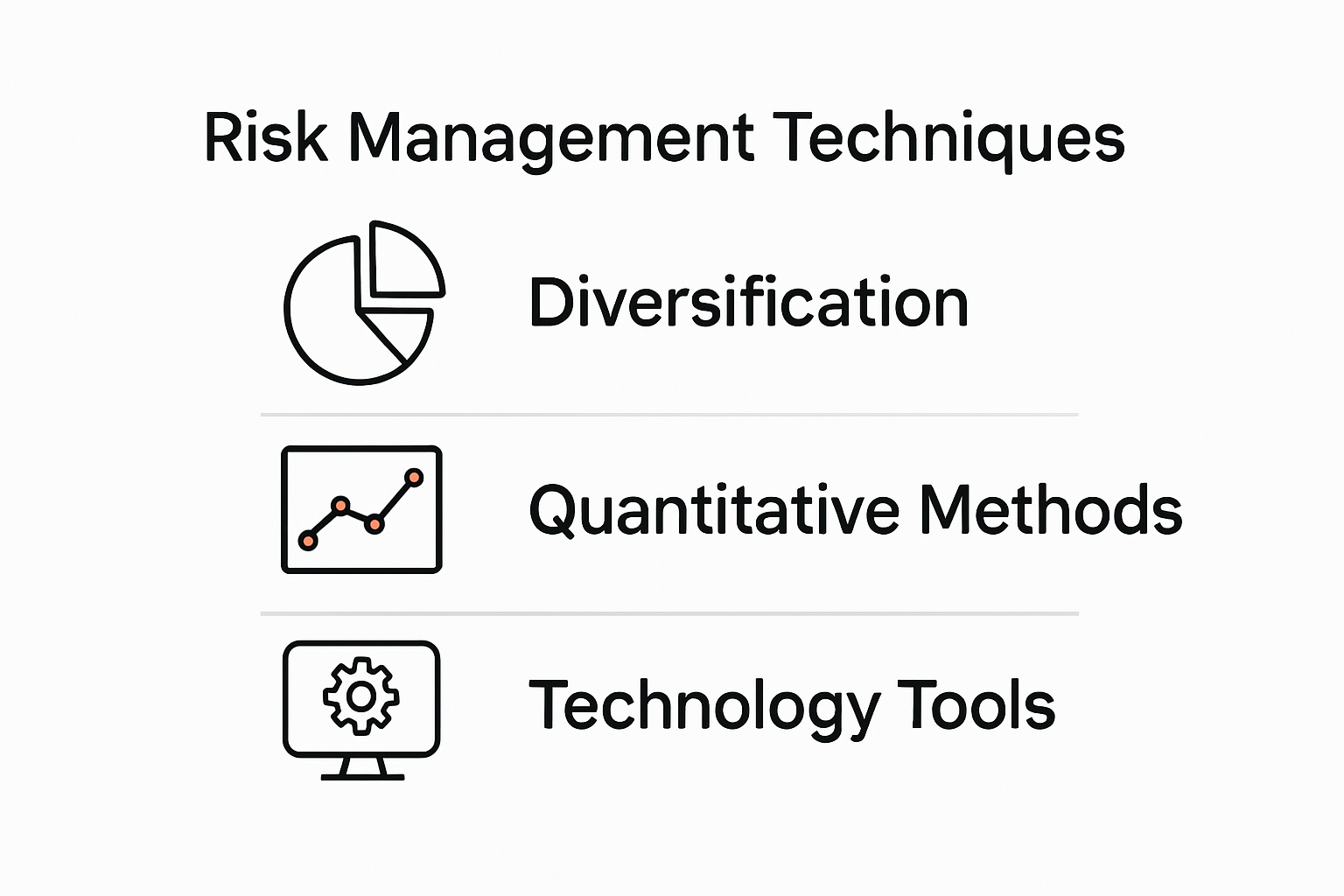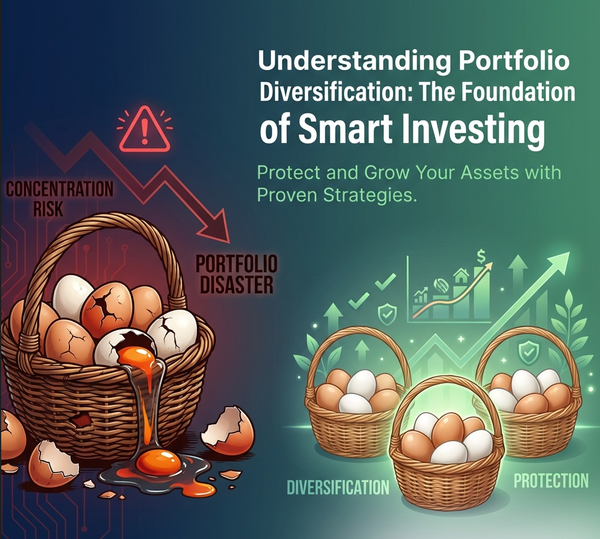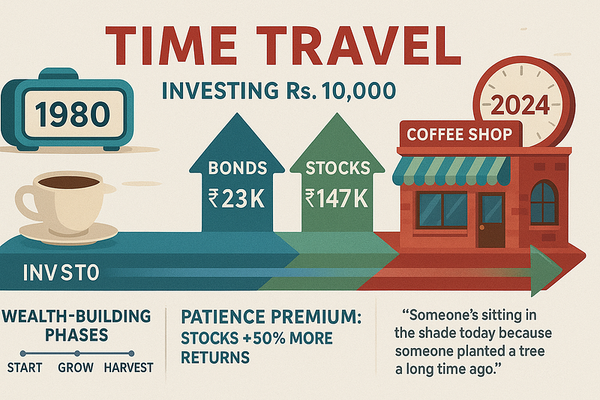Top Risk Management Techniques for Indian Investors 2025
Discover the most effective risk management techniques for Indian investors and traders. Learn how to protect your investments and maximize returns in 2025.

Everyone knows investing in India can be risky and unpredictable. One month your portfolio is up, the next it feels like the floor is slipping away. Yet here’s the strange part. Simply diversifying investments can slash your portfolio risk by up to 40 percent, according to Yale research. That sounds like a silver bullet, right? The bigger surprise is that most Indian investors still miss out on even more powerful risk management tools that could change the game entirely.
Table of Contents
- Understanding Risk Management Techniques In Investing
- Essential Tools And Strategies For Risk Control
- Practical Applications For Indian Retail Investors
- Common Mistakes To Avoid In Risk Management
Quick Summary
| Takeaway | Explanation |
|---|---|
| Understand your risk tolerance | Assessing personal risk preferences helps tailor investment strategies effectively. |
| Diversify across asset classes | Spreading investments reduces overall portfolio volatility, enhancing stability. |
| Leverage technology for analysis | Utilize AI-powered tools for real-time insights and improved decision-making. |
| Regularly reassess your portfolio | Periodic reviews enable adaptability to market changes and personal financial goals. |
| Avoid emotional decision-making | Recognizing psychological biases leads to more rational investment choices. |
Understanding Risk Management Techniques in Investing
Investing inherently involves risk. Smart investors recognize that managing these risks isn't about eliminating them entirely but strategically navigating financial uncertainties. Risk management techniques serve as critical tools for protecting and growing investment portfolios.

The Foundations of Investment Risk Management
Risk management in investing goes beyond simple asset allocation. It requires a comprehensive approach that considers multiple dimensions of financial exposure. Modern Portfolio Theory (MPT), developed by Harry Markowitz in 1952, established fundamental principles for understanding investment risk. This mathematical framework demonstrates that an investor can construct a portfolio to maximize expected returns while minimizing potential losses.
The core principle of MPT is diversification - spreading investments across different asset classes to reduce overall portfolio volatility. By carefully selecting assets with low correlations, investors can create a more stable investment strategy. Research from Yale School of Management suggests that effective diversification can reduce portfolio risk by up to 40% without significantly compromising potential returns.
Advanced Risk Quantification Strategies
Modern investors have access to sophisticated risk management techniques that go beyond traditional approaches. Hierarchical Risk Parity (HRP) represents a cutting-edge portfolio optimization framework that applies machine learning techniques to create more robust investment portfolios. Developed by Marcos López de Prado, HRP addresses limitations in conventional portfolio construction methods by considering complex asset correlations.
The HRP method offers several key advantages:
- Improved Diversification: Better allocation across different asset classes
- Reduced Estimation Error: More resilient against market uncertainties
- Dynamic Risk Allocation: Adapts to changing market conditions
Quantitative risk management also involves advanced statistical techniques like Value at Risk (VaR) and stress testing. These methods help investors understand potential losses under various market scenarios, enabling more informed decision-making.
Implementing Comprehensive Risk Management
Successful risk management requires a multifaceted approach. Investors should:
- Regularly assess and rebalance portfolios
- Understand personal risk tolerance
- Use both quantitative and qualitative risk assessment methods
- Stay informed about market trends and economic indicators
The Robust Portfolio Selection review highlights that modern risk management isn't about perfect prediction but creating resilient investment strategies that can withstand market volatilities. By combining mathematical models, technological tools, and strategic thinking, investors can develop robust approaches to managing financial risks.
Ultimately, risk management is an ongoing process of learning, adapting, and making informed decisions. No single technique guarantees success, but a comprehensive, disciplined approach significantly improves an investor's ability to navigate complex financial landscapes.
To help readers compare the main advanced and traditional risk management strategies discussed, here is a summary table outlining their features:
| Risk Management Technique | Key Features | Main Benefits |
|---|---|---|
| Traditional Diversification | Mix of asset classes, reduces correlation | Cuts volatility by up to 40% |
| Hierarchical Risk Parity (HRP) | Considers complex correlations, AI-driven | Robust to market stress, dynamic |
| Value at Risk (VaR) & Stress Test | Statistical scenario analysis | Quantifies potential losses |
| Stop-Loss Mechanisms | Automated sell at set price | Limits downside loss |
| Options Hedging | Use of derivatives for protection | Shields against major swings |
Essential Tools and Strategies for Risk Control
Effective risk control in investing requires a strategic approach that goes beyond traditional investment methods. Sophisticated investors leverage multiple tools and techniques to protect their portfolios and optimize financial performance.
Diversification and Portfolio Allocation Strategies
Diversification remains a cornerstone of risk management. The Economic Times recommends several critical strategies for mitigating investment risks. These include increasing cash holdings to reduce portfolio volatility and investing in hybrid funds that provide exposure across different asset classes.
Key diversification techniques involve:
- Sector Diversification: Spreading investments across multiple industries to minimize sector-specific risks
- Asset Class Variation: Mixing stocks, bonds, mutual funds, and alternative investments
- Geographical Diversification: Investing in different market regions to reduce localized economic vulnerabilities
Research from Financial Insights emphasizes the importance of monitoring macroeconomic indicators and adjusting portfolios accordingly. This dynamic approach helps investors anticipate and respond to changing economic conditions.
Advanced Risk Mitigation Tools
Modern investors have access to sophisticated risk control mechanisms. Indian Market Tracker highlights several advanced strategies for managing investment risks:
- Stop-Loss Mechanisms: Automatically selling assets when they reach a predetermined price to limit potential losses
- Options Hedging: Using derivative instruments to protect against adverse market movements
- Systematic Investment Plans (SIPs): Averaging out market volatility through regular, fixed investments
These tools enable investors to implement a more proactive approach to risk management. By setting clear boundaries and using automated strategies, investors can protect their capital while maintaining potential for growth.
Risk Assessment and Continuous Monitoring
Successful risk control is an ongoing process that requires continuous evaluation and adjustment. Investors should develop a comprehensive risk assessment framework that includes:
- Regular portfolio review and rebalancing
- Tracking individual asset performance
- Analyzing correlation between different investment components
- Maintaining a clear understanding of personal risk tolerance
Technology plays a crucial role in modern risk management. Advanced analytics and AI-powered tools can provide real-time insights into portfolio performance, helping investors make data-driven decisions quickly and efficiently.
Ultimately, effective risk control is about balance. It requires a combination of strategic planning, sophisticated tools, and a disciplined approach to investment management. By implementing these techniques, investors can create more resilient portfolios that can withstand market uncertainties while pursuing long-term financial goals.
To give a concise view, here's a checklist table summarizing key actions for ongoing risk assessment and monitoring as described above:
| Risk Control Action | Recommended Frequency | Technology Role |
|---|---|---|
| Portfolio review & rebalancing | Quarterly/Annually | Analytics/Alerts |
| Track individual asset performance | Monthly | Real-time dashboards |
| Monitor asset correlations | Quarterly | Correlation analysis tools |
| Assess personal risk tolerance | Annually or at life events | AI-driven risk profiling |
| Stay updated on economic indicators | Ongoing | News & alert apps |
Practical Applications for Indian Retail Investors
Indian retail investors face unique challenges in navigating complex financial markets. Implementing targeted risk management techniques can significantly enhance investment strategies and protect financial interests.
Strategic Asset Allocation
SEBI emphasizes the critical importance of matching investment types with individual investment horizons. This approach requires investors to carefully align their financial instruments with specific time-based goals, whether short-term liquidity needs or long-term wealth generation.
Effective asset allocation strategies for Indian investors include:
- Balanced Portfolio Composition: Mixing equity, debt, and alternative investments
- Age-Based Allocation: Gradually reducing risk exposure as investors approach retirement
- Goal-Oriented Investment: Aligning investment choices with specific financial objectives
Research from ICICI Direct suggests focusing on non-cyclical industries and blue-chip stocks to create more stable investment foundations. These strategies help mitigate market volatility and provide more consistent returns.
Advanced Risk Mitigation Techniques
Modern Indian investors have access to sophisticated risk management tools. India Infoline recommends several advanced techniques:
- Fundamental Analysis: Deeply evaluating a company's intrinsic value before investing
- Pairs Trading: Simultaneously buying and selling correlated securities to minimize market risk
- Dollar-Cost Averaging: Investing fixed amounts regularly to smooth out market fluctuations
- Stop-Loss Orders: Automatically selling assets to limit potential losses
These techniques require discipline and continuous learning. Investors must stay informed about market trends, economic indicators, and individual company performance.
Technology-Enabled Risk Management
Technology has transformed risk management for Indian retail investors. Digital platforms now offer real-time analytics, automated trading tools, and comprehensive portfolio monitoring solutions. These technologies enable investors to:
- Track investment performance instantly
- Receive automated risk alerts
- Analyze portfolio diversification
- Compare investment options
- Understand complex market dynamics
AI-powered investment platforms can provide personalized risk assessments, helping investors make more informed decisions. By leveraging technology, retail investors can access sophisticated risk management tools previously available only to institutional investors.
Successful risk management is not about eliminating risk entirely but understanding and strategically navigating financial uncertainties. Indian retail investors who adopt a disciplined, informed approach can build robust investment portfolios that balance potential returns with calculated risk-taking.
Common Mistakes to Avoid in Risk Management
Risk management in investing is a nuanced discipline where seemingly minor errors can lead to significant financial consequences. Understanding and avoiding common pitfalls is crucial for maintaining a robust investment strategy.
Overconfidence and Emotional Decision Making
Investors frequently underestimate the impact of psychological biases on their financial decisions. The Financial Planning Association highlights that fear and overconfidence can drive irrational investment behaviors.
Common emotional traps include:
- Confirmation Bias: Seeking information that confirms existing beliefs
- Loss Aversion: Holding onto losing investments too long
- Herd Mentality: Making decisions based on market sentiment rather than fundamental analysis
Successful investors develop emotional discipline by:
- Creating predefined investment rules
- Using objective criteria for buy and sell decisions
- Regularly reviewing investment strategies without emotional attachment
Misunderstanding Risk Measurement
The Enterprise Risk Management Initiative warns against oversimplifying risk assessment. Relying exclusively on quantitative measures like standard deviation can create a false sense of security.
Key misconceptions about risk measurement include:
- Assuming Historical Performance Predicts Future Results: Past performance does not guarantee future outcomes
- Overlooking Correlation Between Assets: Failing to understand how different investments interact
- Neglecting Qualitative Risk Factors: Ignoring non-numerical risks like regulatory changes or geopolitical events
A comprehensive risk assessment should combine:
- Statistical analysis
- Fundamental research
- Scenario planning
- Continuous monitoring of market conditions
Inadequate Portfolio Diversification
Poor diversification remains a critical error in risk management. Investors often make mistakes such as:
- Concentrating investments in a single sector
- Overinvesting in familiar companies or industries
- Failing to rebalance portfolios periodically
- Ignoring international investment opportunities
Effective diversification strategies involve:
- Spreading investments across multiple asset classes
- Considering uncorrelated investment instruments
- Regularly reassessing portfolio composition
- Understanding global market dynamics
Risk management is an ongoing process that requires continuous learning and adaptation. Investors who recognize and mitigate these common mistakes can develop more resilient investment strategies. The key is maintaining a balanced approach that combines analytical rigor, emotional discipline, and a willingness to learn from past experiences.
By understanding these potential pitfalls, investors can transform risk management from a defensive strategy into a proactive approach for long-term financial growth.
Frequently Asked Questions
What are the key risk management techniques for Indian investors in 2025?
Key techniques include diversification across asset classes, advanced risk quantification strategies like Hierarchical Risk Parity (HRP), regular portfolio reassessment, and employing technology for continuous monitoring and analysis.
How can diversification reduce portfolio risk for Indian investors?
Research indicates that effective diversification can cut portfolio risk by up to 40%. By spreading investments across various asset classes and sectors, investors can enhance stability and reduce overall volatility.
What tools can Indian investors use for advanced risk mitigation?
Investors can utilize stop-loss mechanisms, options hedging, and Systematic Investment Plans (SIPs) as advanced tools for risk mitigation. These strategies help limit potential losses and provide a more proactive approach to managing financial risks.
Why is continuous monitoring important in risk management?
Continuous monitoring allows investors to track individual asset performance and market trends, enabling them to adjust their portfolios in response to changing conditions. This ongoing process is essential for maintaining a resilient investment strategy.
Supercharge Your Risk Management with AI-Powered Insights
You have seen how quickly markets can shift and how challenging it is for Indian investors to manage portfolio risk, especially with strategies like diversification, stress testing, and continuous tracking. The article revealed just how much advanced risk management matters for securing your financial future. Yet, actually applying these techniques successfully can feel overwhelming if you do not have time or deep market expertise on your side.

Experience a smarter way to handle risk and unlock peace of mind. StockSageAI uses artificial intelligence to simplify portfolio analysis, personalize stock recommendations, and give you real-time, actionable insights tailored to your goals and risk profile. Whether you are a first-time investor concerned about volatile returns or a busy professional looking for clear signals, StockSageAI transforms complex data into simple decisions. Join now and discover how features like AI-driven portfolio curation, visual performance dashboards, and an on-demand chatbot can help you cut portfolio risk and stay a step ahead of market shifts. Visit StockSageAI today and start building a safer, smarter investment strategy immediately.




